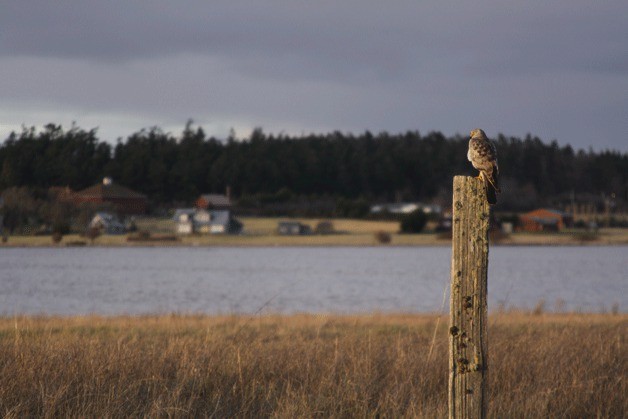Just moments after stepping out of his car, Jay Adams is alerted to a familiar sound.
The high-pitched chirp of a songbird pierces the still quiet of an early afternoon. Barely audible, it takes a trained ear to detect and a birder’s experience to identify.
Adams goes into action, blowing short wisps of air to create a faint whistling sound. This is called pishing, a technique birders use in the field to attract birds so they can get a better look, though seeing the bird isn’t always necessary.
“That’s a red-breasted nuthatch,”Adams said, recognizing the call.
“I bird a lot by ear.”
Adams is delighted by the results of a brief scouting trip at the edge of dense woods along a residential street in Coupeville.
In time, he hears or sees two other types of song birds — a black-capped chickadee and golden-crowned kinglet — as well as a northern flicker.
He anticipated the location would be good because birds are generally more active in this sort of setting at the woods’ edge and, in this case, could be spotted and heard from easily accessible vantage points.
Adams and other birders from Whidbey Audubon Society will be out in force Saturday, Dec. 19, using their binoculars and spotting scopes to locate, identify and count birds throughout North and Central Whidbey.
It’s part of the annual citizen-science tradition played out throughout North America this time of year that’s known as the Audubon Christmas Bird Count.
The Audubon count started in 1900, with the compiled data proving helpful to researchers, biologists, wildlife agencies and others interested in studying birds’ health and populations across the continent.
Whidbey’s count dates back only to 1987 and is now broken into two counts on opposite ends of the island.
The north count, which stretches from just south of Dugualla Bay to Crockett Lake in Coupeville, is Dec. 19, while the south count, which encompasses Greenbank and points south and even part of Camano Island, is Jan. 2.
Teams have already been assembled, each with specific locations to monitor during their area’s 24-hour count period. Deception Pass State Park is covered in a different count conducted by another Audubon chapter.
The public can help by placing feed in their bird feeders and allowing access on their properties for birders to collect data, said Adams, who is leading the north count.
Those interested in directly participating in future counts can contact Whidbey Audubon by going to its website at www.whidbey
audubon.org
Winter is a good time to spot many different bird species.
The fall and winter migration periods bring both an abundance and wide variety of birds to Whidbey, making the island a popular destination for birds and birders alike during the winter months.
“Winter is awesome,” said Govinda Rosling, a birder from Clinton and Whidbey Audubon member who will lead the south count. “There are no leaves on the trees.
“There’s no bad weather, just bad clothing.”
Whidbey is located in the Pacific Flyway, a north-south migration path for birds. In the fall and winter, a variety of birds arrive from Alaska, British Columbia and other northern reaches.
The best birding spots are Crockett Lake, Deer Lagoon and the Crescent Harbor Marshes. They are sites identified as Important Birding Areas by the National Audubon Society because of their pristine habitat.
However, during the Christmas Bird Count, birders flock to points near and far, including residential areas, to cover their bases and compile the best data possible.
Adams, who lives in Coupeville, has been monitoring, identifying and appreciating birds for more than three decades but is a newcomer to Whidbey Island.
He came to the island from Maine a year ago and immediately got involved with the Whidbey Audubon Society and now is a member of the board of directors.
“Whidbey Island is not as birdy as many places,” Adams said. “There are not as many species or individuals. On the other hand, there’s a lot of habitat.”
Adams kept his eyes and ears open as he continued to walk along the edges of Wilkes Street near a dense patch of woods in Coupeville this week.
He was pleased by what he heard.
“The trick to birding by hearing is, ‘How many are you hearing?’” he said.
It’s amazing how a little pishing by Adams tended to stir up the birds’ curiosity. He made the sound with his mouth, which mimics a bird’s alarm call, and the chirps and peeps increased and could be heard a little closer as some birds emerged from the brush.
It’s clear the birds wanted to know what Adams was up to.
“If more chickadees respond by doing their alarm calls, the nuthatches make their own alarm calls, then other birds seem to respond,” Adams said.
Spotting a rare bird, or one not commonly found in a certain region, is always a highlight for birders; however, just getting outdoors and observing nature fills a niche to many.
“I’ve never had a bad day out in the field,” said Adams, who used to be an avid golfer.
“When I think about it, I don’t think I’ve ever thrown my binoculars.”



